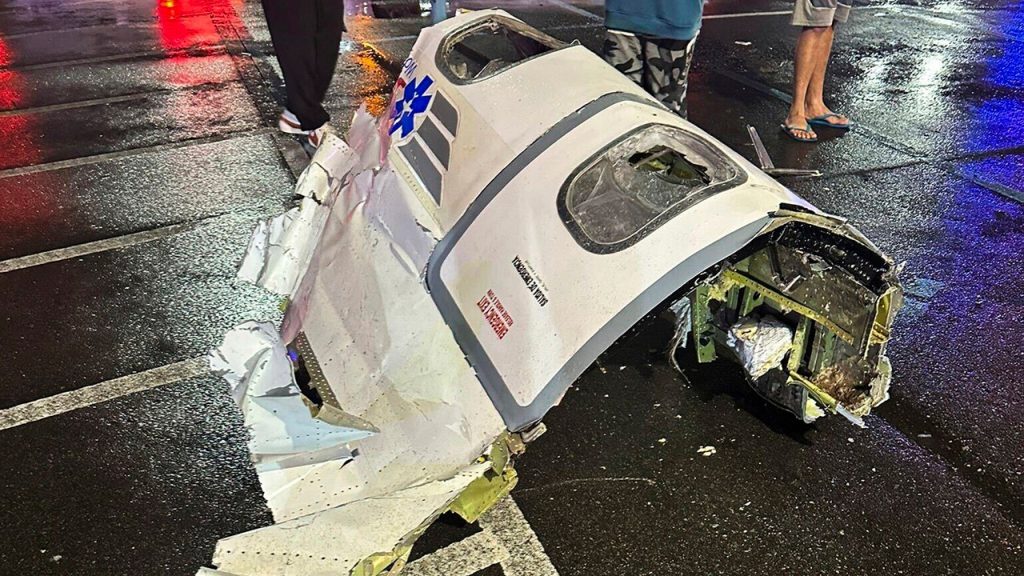The tragic crash of a medical ambulance jet in Philadelphia on a Friday evening has raised concerns and sparked investigations, especially given the operating company’s involvement in a previous fatal air incident. The Learjet 55, operated by Jet Rescue Air Ambulance, was en route from Northeast Philadelphia Airport to Springfield-Branson National Airport in Missouri when it crashed near Roosevelt Mall, claiming the lives of all six individuals on board: two crew members (pilot and copilot), two medical personnel (physician and paramedic), a pediatric patient, and her mother. All were Mexican nationals. The young patient had received life-saving medical treatment in the U.S. and was being transported home, with a planned technical stop in Missouri for refueling before continuing to Tijuana, Mexico. The crash resulted in a devastating scene, with the ensuing fire engulfing six nearby homes and six cars due to the highly flammable jet fuel. The incident has prompted a multi-agency investigation, with the National Transportation Safety Board leading the effort, assisted by the Federal Aviation Administration and the Bureau of Alcohol, Tobacco, Firearms, and Explosives.
Adding to the gravity of the situation, this is the second fatal crash involving a Jet Rescue Air Ambulance aircraft in just over a year. In November 2023, a Learjet 35A operated by the same company crashed upon landing at Cuernavaca Airport in Morelos, Mexico, after departing from Toluca International Airport. That incident resulted in the loss of all five crew members on board, with no passengers present. The recurring nature of these incidents involving the same operator raises serious questions about potential systemic issues within the company’s operations, including maintenance protocols, pilot training, and safety management systems. These questions will undoubtedly be central to the ongoing investigations.
The Philadelphia crash has sent shockwaves through the community and beyond, underscoring the inherent risks associated with air ambulance operations. The families of the victims, both those on board and those whose homes were damaged, are grappling with immense grief and loss. Local and national authorities have expressed condolences and pledged support to those affected. The incident also highlights the crucial role of air ambulance services in providing critical care transport, particularly for patients in need of specialized treatment not readily available in their local areas. The balance between providing this essential service and ensuring the safety of all involved remains a critical challenge for the industry.
The details surrounding the Philadelphia crash continue to emerge as investigations progress. Preliminary reports suggest the plane experienced difficulties shortly after takeoff, leading to the rapid descent and subsequent impact. The exact cause of the crash, however, remains undetermined and will be the focus of the NTSB’s investigation. Investigators will be examining a range of factors, including pilot performance, aircraft maintenance records, weather conditions, and air traffic control communications, to piece together the events leading to the tragedy. The black boxes, containing flight data and cockpit voice recordings, will be crucial in providing insights into the final moments of the flight.
The investigation into the Philadelphia crash will likely be a lengthy and complex process, involving meticulous analysis of evidence and expert testimony. The NTSB will issue a preliminary report within a few weeks, providing an initial overview of the incident and any immediate safety recommendations. A final report, which will include the probable cause of the crash and any contributing factors, will likely take several months or even years to complete. The findings from this investigation will be critical in informing future safety measures and preventing similar tragedies from occurring. The aviation industry as a whole will be closely watching the outcome of this investigation, as the lessons learned will have implications for air ambulance operators and the broader aviation community.
Beyond the immediate investigation, the Philadelphia crash raises broader questions about the oversight and regulation of air ambulance services. The industry has faced scrutiny in recent years regarding safety standards, operational practices, and cost transparency. This latest incident is likely to renew calls for stricter regulations and enhanced safety protocols to ensure the safety and well-being of both patients and crew members. The investigation’s findings will be instrumental in shaping future policy decisions and industry best practices, with the ultimate goal of preventing future tragedies and improving the safety of air ambulance operations. The focus will be on learning from this tragic event to ensure safer air medical transport for all.

